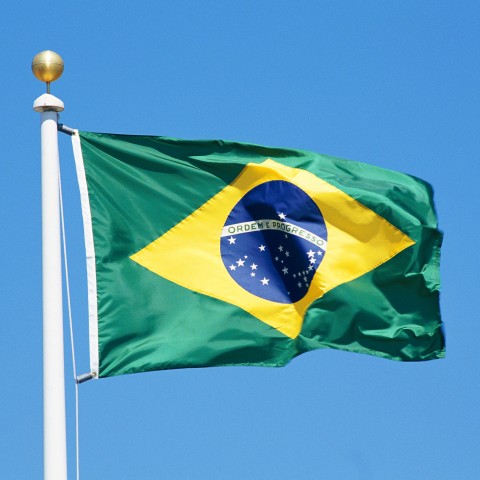
National anthems are all about expressing patriotic sentiments, and much can be learned about a country’s history by discovering its anthem. This is true when it comes to the Hino Nacional Brasileiro (“Brazilian National Anthem”).
Brazil’s Anthem is long, with a composition that resembles early Romantic Italian music and lyrics written in 1909. Its melody is strong and enthusiastic – as a result, it is easy to see Brazilians proudly chanting it in sporting events and similar situations in which the anthem is played.
If we are being honest, it isn’t easy to understand the lyrics of Brazil’s national anthem. Inversions are often used, and older words that are not used anymore appear very often. So in this article, we will examine the lyrics of the national anthem for Brazil, as well as its history and uses.

The Brazilian Flag
 Table of Contents
Table of Contents
- Lyrics of Brazil’s Anthem in English and Portuguese
- History of the Brazilian National Anthem
- Occasions When You Can Hear the Brazilian Anthem
- Continue Learning More Portuguese with PortuguesePod101
1. Lyrics of Brazil’s Anthem in English and Portuguese
Let’s take a look at the two consecutive stanzas of the Brazilian National Anthem. The lyrics are complex, with metaphors and rarely-used words. Since it was written in the Parnassian style, it prioritizes the beauty of the form over clarity, opting for ornate language and many inversions.
Below, we provided two translations: the first is the more literal one, keeping the inversions and older vocabulary and grammar; the second is a more direct and easier translation to simplify your understanding of the meaning of the Brazilian anthem.
And if you want to listen to the Brazilian National Anthem being sung, you can check out this video.
First Stanza
Verse 1
| Ouviram do Ipiranga as margens plácidas De um povo heróico o brado retumbante, E o sol da liberdade, em raios fúlgidos, Brilhou no céu da pátria nesse instante. | The placid banks of the Ipiranga heard the resounding shout of a heroic folk, And the sun of Liberty in shining beams shone in the homeland’s sky at that instant. | The resounding cry of a heroic people was heard at the peaceful banks of the Ipiranga river And the dazzling rays of the sun of Liberty Bathed our country in their brilliant light. |
| The Ipiranga river is the stream in the city of São Paulo where Prince Dom Pedro, the future Emperor Dom Pedro I of Brazil, declared Brazilian independence from Portugal. The “sun of Liberty” is a reference to independence as well. | ||
Verse 2
| Se o penhor dessa igualdade Conseguimos conquistar com braço forte, Em teu seio, ó liberdade, Desafia o nosso peito a própria morte! | If the pledge of that equality we managed to conquer with strong arm, In thy bosom, O Freedom, our chest defies death itself! | If with strong arm we have succeeded In winning a pledge of equality, In your bosom, O Liberty, Our hearts will defy death itself! |
| “Penhor dessa igualdade” is used figuratively to refer to the guarantee that there will be freedom, independence. | ||
Verse 3
| Ó Pátria amada, Idolatrada, Salve! Salve! | O beloved, idolized homeland, Hail! Hail! | O adored Fatherland, Revered, Hail! Hail! |
Verse 4
| Brasil, um sonho intenso, um raio vívido De amor e de esperança à terra desce, Se em teu formoso céu, risonho e límpido, A imagem do Cruzeiro resplandece. | Brazil, an intense dream, a vivid ray of love and hope to earth descends, If in thy beautiful sky, smiling and limpid, the image of the (Southern) Cross blazes. | Brazil, a dream sublime, a vivid ray of love and hope descends to earth, Where in your clear, hopeful, beautiful skies The image of the Southern Cross shines forth. |
| Cruzeiro is a reference to the Southern Cross (also known as Crux) constellation of the Southern sky, with four bright stars in a cross shape. | ||
Verse 5
| Gigante pela própria natureza, És belo, és forte, impávido colosso, E o teu futuro espelha essa grandeza. | Giant by thine own nature, Thou art beautiful, strong, a fearless colossus, And thy future mirrors that greatness | Vast by its own nature, You are fair, you are strong, brave colossus, And your future mirrors that greatness. |
Verse 6
| Terra adorada, Entre outras mil, És tu, Brasil, Ó Pátria amada! Dos filhos deste solo és mãe gentil, Pátria amada,Brasil! | Adored Land Amongst a thousand others art thou, Brazil, O beloved homeland. Of the sons of this ground thou art kind mother, Beloved homeland, Brazil! | Land adored Above all others, It is you, Brazil, Beloved Fatherland! You are gentle mother of the children of this soil, Beloved land, Brazil! |

Cruzeiro do Sul (“Southern Cross”)
Second Stanza
Verse 7
| Deitado eternamente em berço esplêndido, Ao som do mar e à luz do céu profundo, Fulguras, ó Brasil, florão da América, Iluminado ao sol do Novo Mundo! | Eternally lying on splendid cradle, to the sound of the sea and under deep sky light, Thou flashest, Brazil, rosette of America, illuminated by the sun of the New World! | Laid out eternally in the splendor of nature, To the sound of the sea and the light of the deep skies, You shine, O Brazil, ornament of America, Illumined by the sun of the New World! |
Verse 8
| Do que a terra, mais garrida, Teus risonhos, lindos campos têm mais flores; “Nossos bosques têm mais vida”, “Nossa vida” no teu seio “mais amores.” | Than the more garish land, thy smiling, pretty prairies have more flowers;” Our groves have more life”, “Our life” in thy bosom “more loves.” | Your fair, smiling fields have more flowers Than the most gracious land; “Our forests have more life”, “Our lives” in your bosom “more loves.” |
| The sentence “Nossos bosques têm mais vida” (“Our groves have more life”) – as well as the following line – are citations from the famous poem “Canção do Exílio“, by Gonçalves Dias. | ||
Verse 9
| Ó Pátria amada, Idolatrada, Salve! Salve! | O beloved, idolized homeland, Hail! Hail! | O adored Fatherland, Revered, Hail! Hail! |
Verse 10
| Brasil, de amor eterno seja símbolo O lábaro que ostentas estrelado, E diga o verde-louro dessa flâmula– “Paz no futuro e glória no passado.” | Brazil, of eternal love be a symbol, the starred labarum that thou displayst, And say the green of this pennant, “Peace in the future and glory in the past.” | Brazil, may the starry flag you display Be a symbol of eternal love, And may the green and yellow of this flag proclaim: “Peace in the future and glory in the past.” |
Verse 11
| Mas, se ergues da justiça a clava forte, Verás que um filho teu não foge à luta, Nem teme, quem te adora, a própria morte. | But if thou raisest the strong mace of justice, thou wilt see that a son of thine flees not from battle, nor do those who love thee fear their own death. | But if you draw forth the strong mace of justice, You will see that a child of yours does not flee from a fight, Nor do those that adore you fear their own death. |
Verse 12
| Terra adorada,Entre outras mil, És tu, Brasil, Ó Pátria amada! Dos filhos deste solo és mãe gentil, Pátria amada, Brasil! | Adored Land Amongst thousand others art thou, Brazil, O beloved homeland. Of the sons of this ground thou art kind mother, Beloved homeland, Brazil! | Land adored Above all others, It is you, Brazil, Beloved Fatherland! You are gentle mother of the children of this soil, Beloved land, Brazil! |

Brazil’s anthem makes many references to nature.
- ➜ This audio lesson about Independence Day in Brazil is a great follow-up to this article!
2. History of the Brazilian National Anthem
Time to understand how the Brazilian Anthem came about. As a little heads up, the melody and lyrics were created at different times, so we will also discuss them separately.
In 1822, Dom Pedro I proclaimed Brazilian independence from Portugal. Dom Pedro I, the first Brazilian Emperor, then composed an anthem celebrating the Independence. This composition is still an official patriotic song in Brazil, called the Independence Anthem. But in 1831, Pedro I abdicated and left for Europe – and the anthem he composed fell in popularity.
Sensing an opportunity, a man named Francisco Manuel da Silva presented to the public the melody of the anthem-to-be on April 13, the same day the previous Emperor left the country. Now, this day is considered the Day of the Brazilian National Anthem. No one knows when the melody was really composed. Some believe it dates back to 1822, others that it was composed in 1831 itself.
At first, the melody gained accompanying lyrics written by Appeals Judge Ovídio Saraiva de Carvalho e Silva, celebrating the abdication and Pedro II’s (the then 5-year-old son of Pedro I) accession to the Brazilian Throne. But the Hino ao 7 de Abril (“April 7 Hymn”), as the lyrics were then called, were not very popular. The melody, however, continued to be played in public ceremonies. As the years passed, the composition came to be adopted as the national anthem.
When Pedro II came of age in 1841, new lyrics were proposed, but not for long. Emperor Pedro II would mandate that the national anthem should be played without lyrics whenever he presented in public and in military and civil solemnities.
Some time passed until the Proclamation of the Republic in 1889. With the change in regime, a competition was launched to choose a new anthem. However, the winning composition didn’t stick – there was a popular outcry against it, and the Provisional Government formalized that the melody by Francisco Manuel da Silva would be the Brazilian National Anthem.
Until 1922, no official lyrics existed. In 1909, another competition ended up selecting a poem by Joaquim Osório Duque-Estrada, which was adapted to fit the anthem’s melody. However, the lyrics were not officialized, and different states even adopted different lyrics. In the following years, Duque-Estrada continued to make changes to his original version until 1922. That year, which marked the 100-year anniversary of Brazilian Independence, was also when Duque-Estrada’s lyrics were finally declared official.

Sheet music for the Brazilian Anthem
- ➜ Do you want to improve your Portuguese as you learn more about Brazilian History? PortuguesePod101 has many audio lessons doing both, like the beginner-level “Its All Brazilian History” or “Experience Brazil’s Rich History.”
3. Occasions When You Can Hear the Brazilian Anthem
Now that you know the lyrics to the Brazilian National Anthem and its history, are you looking for an opportunity to hear it being sung live? There are a few different situations in which that might happen.
The anthem is played in official civil and military events, alongside the hoisting of the flag. It is also mandatory in Brazil that, at least once a week, the national anthem be played in schools – and students should be taught how to sing it. You will also hear it in sporting events, for example, before a soccer match or when a Brazilian athlete is receiving an Olympic medal.
Brazil’s national anthem has two stanzas, as we’ve already seen. Until 2016, only the first stanza was sung in sporting events. Now, the anthem is played in its entirety, which takes around 3 minutes and a half. Brazilian law also describes how people should behave when the national anthem plays: people should listen to it standing up, without any headwear. If the instrumental version is playing, people should remain silent. Clapping or whistling during the anthem is forbidden, but clapping afterward is off the hook.
But if you were curious to see some other versions of the Brazilian anthem, you can do it… but it is not totally legal. The Federal Constitution forbids any arrangements other than the official one. But with a quick search on YouTube you can find versions of the anthem in Brazilian musical styles like Forró, Samba e Pagode. And, of course, Brazilians also play around with the lyrics from time to time – but for that, you will have to attend a soccer match in the country to find out first-hand!

Ready to sing along to the Brazilian Anthem?
4. Continue Learning More Portuguese with PortuguesePod101
We hope this article helped you understand this important national symbol of Brazil! The Brazilian National Anthem praises the beauty, size, and richness of the country – and even if you haven’t been there yet, it’s easy to see why.
If you are able to understand the complex lyrics of this anthem, then you are ahead of many native speakers. High five, and well done!
And please let us know what you think of this article. Was it helpful for you? Do you think we missed any useful explanations about the national anthem for Brazil?
Now, continue learning Portuguese with the hundreds of free Portuguese resources and the many vocabulary lists available on PortuguesePod101.com. Go ahead and choose your favorite tools to expand your learning opportunities.
If you want to take your learning experience further, members of PortuguesePod101.com get access to the largest language lesson library in the world, with thousands of real lessons by real teachers. With Premium PLUS, you will have your own personalized learning program, with weekly assignments based on your needs! Perfect for anyone who wants to learn from anywhere, feel motivated, and be ready to speak Portuguese with confidence. And in the meantime, continue exploring PortuguesePod101!









